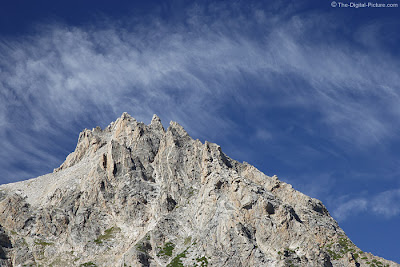The Teton mountains are characterized by a relatively straight line of very tall peaks running north south and reaching over 3000 meters above sea level. The mountains tend to be jagged and pointed at their peaks. In fact, the name of the mountain range comes from the French word for a woman's nipple - teton. The early French trappers saw these mountains and they were reminded of ...... well you know the French. There was something else vaguely familiar about these particular peaks but for a while I could not put my finger on what it was.
Next to this impressive range of mountains, is an immense valley called the Jackson Hole. At one point several million years ago, a crack or fault formed in the Earth's crust. As often happens with faults in the crust, the rock on the western side of the crack was pushed up while the rock on the eastern side slipped down. All the top layers of younger rock on the western mountains were gradually removed by erosion and glaciers while the sedimentary rock valley on the eastern side of the fault remained mostly in tact. Tranquil lakes were formed on the east side of the mountains where the glaciers pushed large quantities of rock and gravel down through the mouths of the steep canyons between the mountains. Thus, we were able to enjoy magnificent scenery made up of jagged mountains revealing ancient very hard rock billions of years old, sitting next to glacier formed lakes to the east of those mountains, all overlooking a large flat plateau made of younger sedimentary rock covered by gentle rolling hills of sage and pine trees.
Then one day I visited this blog to make an entry and after looking at the picture that I severl months ago chose to headline this blog it occurred to me why the Teton Mountians looked so familiar. The picture appearing above overlooks the Gulf of Eilat and the mountains surrounding it. Similar to the Tetons, many of the peaks are made of very old very hard rocks and have the same jagged look and even some of the same dark coloring (if anything even darker). While the fault line along the Teton mountains was caused by the crashing of too massive plates in the earth's crust, the fault line around Eilat were formed by to plates that continue to move away from each other creating the great rift valley that we call the Dead Sea Valley and the Jordan valley - the lowest elevations on earth. Similarly, the faults had around Eilat had created mountain ranges where on one side of the fault the crust was moving up and the other side of the fault slipping down. The erosion of surface rocks on the higher peaks flowed down into the Dead Sea rift valley to reveal sporadically the very old rock layers below.
I have often heard comments regarding the Uniqueness of Eretz Yisrael. Located as it is at the convergence of three continents it contains a disproportionate number of species of plants and animals often combining varieties native to Africa and other native to Europe or Asia. The same seems to be true of the landscape. The Talmud suggests that ten portions of wisdom came down to the world and 9 were allocated to Eretz Yisrael. Eretz Yisrael has it all (albeit on a smaller scale), mountians and waterfalls, valleys and beaches, volcanic plateaus and ancient peaks, petrified trees and fossils, Karsitc caves and Stalactite/Stalagmite caverns, all in relatively close proximity to one another. As I recently discovered, even some of the characteristics the Grand Tetons have been duplicated in the grand mountain ranges surrounding the Israeli port city of Eilat.




No comments:
Post a Comment